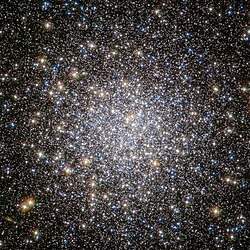Messier 5
| Kugelsternhaufen Messier 5 / NGC 5904 | |
|---|---|
 | |
| SDSS, Bildfeld 24' × 24' | |
| AladinLite | |
| Sternbild | Schlange |
| Position Äquinoktium: J2000.0, Epoche: J2000.0 | |
| Rektaszension | 15h 18m 33,7s [1] |
| Deklination | +02° 04′ 58″ [1] |
| Erscheinungsbild | |
| Konzentrationsklasse | V [2] |
| Helligkeit (visuell) | 5,7 mag [3] |
| Winkelausdehnung | 23′ |
| Physikalische Daten | |
| Rotverschiebung | +0,000173 ± 0,000002 |
| Radialgeschwindigkeit | (+51,8 ± 0,5) km/s |
| Entfernung | 23,1 kLj [4] |
| Durchmesser | 200 Lj |
| Alter | 13 Mrd. Jahre |
| Geschichte | |
| Entdeckung | G. und M. Kirch |
| Entdeckungsdatum | 5. Mai 1702 |
| Katalogbezeichnungen | |
| M 5 • NGC 5904 • C 1516+022 • GCl 34 • | |
Messier 5 oder NGC 5904 ist ein Kugelsternhaufen im Sternbild Schlange und etwa 23.000 Lichtjahre vom Sonnensystem entfernt. Für Amateurteleskope ist er einer der schönsten Kugelhaufen.
Mit einer scheinbaren Helligkeit von etwa 5,8 mag lässt sich Messier 5 in sehr klarer Nacht und an einem Ort mit wenig Lichtverschmutzung schon mit bloßem Auge als sternartiges Objekt erkennen. In kleinen Fernrohren werden am Rand bereits Einzelsterne sichtbar, doch wirkt das Zentrum auch im Achtzöller noch etwas verschwommen, weil unaufgelöste Sterne eine Art Schimmer erzeugen[5]. Im untenstehenden Bild sind einige tausend dieser schwachen Sterne zu sehen. Ab 30–40 cm Öffnung lässt sich auch der etwas längliche Kern des Haufens auflösen.
Der Kugelsternhaufen wurde von Gottfried und Maria Kirch am 5. Mai 1702 entdeckt und von Charles Messier am 23. Mai 1764 in seinen Messier-Katalog aufgenommen.[6]

Literatur
- König, Michael & Binnewies, Stefan (2023): Bildatlas der Sternhaufen & Nebel, Stuttgart: Kosmos, S. 344
Weblinks
- Spektrum.de: Amateuraufnahmen [1]
- Breathing new life into an old cluster (engl.)
- Cosmic fairy lights (engl.)
Einzelnachweise
- ↑ NASA/IPAC EXTRAGALACTIC DATABASE
- ↑ Harlow Shapley, Helen B. Sawyer: A Classification of Globular Clusters. In: Harvard College Observatory Bulletin. Band 849, 1927, S. 11–14, bibcode:1927BHarO.849...11S.
- ↑ SEDS: NGC 5904
- ↑ Messier 5 bei SEDS
- ↑ Bernd Koch, Stefan Korth Die Messier-Objekte. Die 110 klassischen Ziele für Himmelsbeobachter. Kosmos-Verlag Stuttgart 2010
- ↑ Seligman
Auf dieser Seite verwendete Medien
Bildtafel der 110 Messier-Objekte. Diese Datei wird in der w:de:Template:Navigationsleiste Messierobjekte als Imagemap genutzt. Sie darf daher nicht durch eine andere Version überschrieben werden!
Autor/Urheber: Sloan Digital Sky Survey, Lizenz: CC BY 4.0

Angle of view: 24' x 24' (0.3515625" per pixel), north is up.
Details on the image processing pipeline: https://www.sdss.org/dr14/imaging/jpg-images-on-skyserver/The globular cluster Messier 5, shown here in this NASA/ESA Hubble Space Telescope image, is one of the oldest belonging to the Milky Way. The majority of its stars formed more than 12 billion years ago, but there are some unexpected newcomers on the scene, adding some vitality to this aging population.
Stars in globular clusters form in the same stellar nursery and grow old together. The most massive stars age quickly, exhausting their fuel supply in less than a million years, and end their lives in spectacular supernovae explosions. This process should have left the ancient cluster Messier 5 with only old, low-mass stars, which, as they have aged and cooled, have become red giants, while the oldest stars have evolved even further into blue horizontal branch stars.
Yet astronomers have spotted many young, blue stars in this cluster, hiding amongst the much more luminous ancient stars. Astronomers think that these laggard youngsters, called blue stragglers, were created either by stellar collisions or by the transfer of mass between binary stars. Such events are easy to imagine in densely populated globular clusters, in which up to a few million stars are tightly packed together.
Messier 5 lies at a distance of about 25 000 light-years in the constellation of Serpens (The Snake). This image was taken with Wide Field Channel of Hubble’s Advanced Camera for Surveys. The picture was created from images taken through a blue filter (F435W, coloured blue), a red filter (F625W, coloured green) and a near-infrared filter (F814W, coloured red). The total exposure times per filter were 750 s, 400 s and 567 s, respectively. The field of view is about 2.6 arcminutes across.




